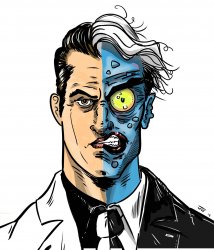- Sep 22, 2013
- 4,956
- 250
- 85
We celebrate comic book 'super-villains' such as Brainiac and Clayface and Poison Ivy in movies and storybooks.
We talk about the 'spiritual catharsis' of surviving a terrible earthquake.
We catalogue achievements and blunders in the world of fashion.
We describe regular forms (Euclidean shapes) in geometry and talk about amorphous or chaotic objects (non-Euclidean geometry).
Why?
We're very fascinated by precision and symmetry and beauty (or harmony), so we're 'curious' intellectually about chaos, jagged edges, asymmetry, and therefore whatever is considered the 'opposite' of beauty.
We can therefore attempt to construct a model for beauty itself and its 'shadow' of non-beauty (or ugliness).
What is The Ugly? Can ugliness reveal why we're fascinated by comic book super-villains or earthquakes?
There must be a relationship between 'undesirable chaos' (disorder creating confusion) and perceptions that are intolerable (e.g., murder, arson, accidents, etc.).
Many consider arson and the wondrous but devastating (and painful) element of fire as great 'subjects' to use for the study of the contours between beauty and ugliness, since fire is 'undesirable chaos' and therefore representative of confusing geometry.
The psychological-thriller film The Ugly explores the feeling of being lost in an institution plagued by monstrosity.
The Ugly (Film)

We talk about the 'spiritual catharsis' of surviving a terrible earthquake.
We catalogue achievements and blunders in the world of fashion.
We describe regular forms (Euclidean shapes) in geometry and talk about amorphous or chaotic objects (non-Euclidean geometry).
Why?
We're very fascinated by precision and symmetry and beauty (or harmony), so we're 'curious' intellectually about chaos, jagged edges, asymmetry, and therefore whatever is considered the 'opposite' of beauty.
We can therefore attempt to construct a model for beauty itself and its 'shadow' of non-beauty (or ugliness).
What is The Ugly? Can ugliness reveal why we're fascinated by comic book super-villains or earthquakes?
There must be a relationship between 'undesirable chaos' (disorder creating confusion) and perceptions that are intolerable (e.g., murder, arson, accidents, etc.).
Many consider arson and the wondrous but devastating (and painful) element of fire as great 'subjects' to use for the study of the contours between beauty and ugliness, since fire is 'undesirable chaos' and therefore representative of confusing geometry.
The psychological-thriller film The Ugly explores the feeling of being lost in an institution plagued by monstrosity.
The Ugly (Film)

